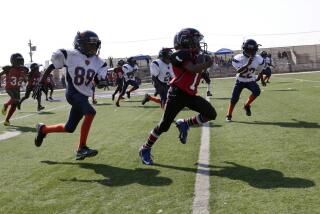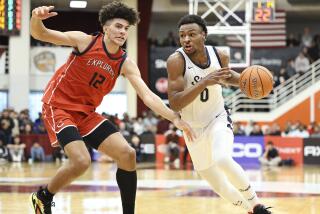ER visits for concussions soar among child athletes
The number of children in the U.S. seeking emergency medical care for concussions incurred playing competitive sports more than doubled in the five years leading up to 2005, according to a study published Monday in the journal Pediatrics.
Much of that increase came not from high school athletes who have been the mainstay of emergency-room visits for concussions, but from middle-schoolers and even elementary school students who have flocked to play on elite travel teams and in competitive youth leagues across the country. Fully 40% of the sports-related pediatric concussion patients seen in ERs were between the ages of 8 and 13, the study found.
Strikingly, the increase in concussions came against the backdrop of declining participation in organized sports among youth in those years, noted the research team from Rhode Island.
Combing through injury reports provided by hospitals, the researchers tallied 502,000 cases of children and teens visiting emergency departments for concussions between 2001 and 2005. Roughly half of those visits were for concussions related to sports and other recreational activities.
The true number was almost certainly higher, however, because studies that rely on ER visits to track brain injuries don’t include cases in which parents waited to bring their children to a doctor the next day or never brought them to a physician at all, said UCLA pediatric neurologist Christopher Giza, who wasn’t involved in the study.
The findings prompted the American Academy of Pediatrics to publish an updated “clinical report” outlining what is known about concussion care in children and adolescents.
That report, which also appears in the journal, underscores growing evidence that younger children’s brains are not only more susceptible to injury, but those injuries may take longer to heal and can be more damaging than concussions in adolescents or adults.
A 2007 estimate by the Centers for Disease Control and Prevention suggested children and adults sustain as many as 3.8 million sports- and recreation-related concussions a year in the United States. But “data are significantly lacking about concussions in grade-school and middle-school athletes, which highlights the need for more research,” wrote Drs. Mark E. Halstead and Kevin E. Walter on behalf of the academy’s Council on Sports Medicine and Fitness.
Giza said Pediatrics’ review of clinical findings on concussions will help forge consensus among coaches, parents and physicians about what to do when a child is dazed after a rough tackle or knocks heads hard with a teammate in a lunge for the ball.
“There’s sort of an old-school notion that a kid gets his or her bell rung and toughs it out and keeps participating and bounces back,” Giza said. But with evidence piling up that concussions are especially dangerous for younger kids, coaches should take “a more conservative approach,” he said.
The Rhode Island researchers added that parents, coaches and physicians need better guidelines for recognizing brain trauma in younger kids, determining when and how long to sideline them and finding ways to protect them from long-term harm.
In May 2009, the state of Washington was the first to pass legislation requiring that any student-athlete suspected of having a concussion be removed from the game and not return to play until cleared by a licensed medical professional. Several states, including California, have since adopted similar laws.
melissa.healy@latimes.com







